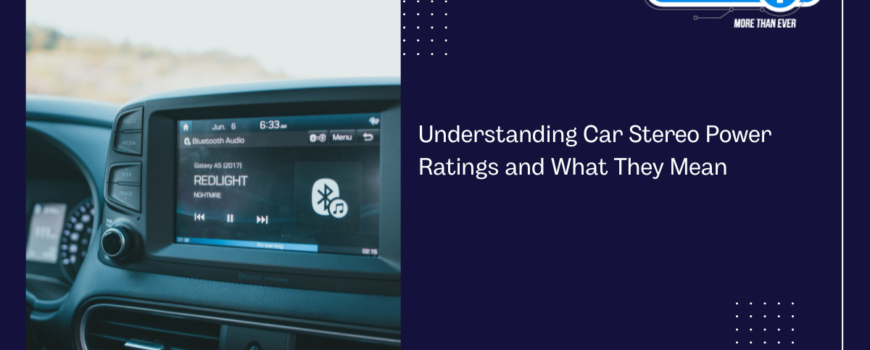Understanding car stereo power ratings can initially seem complex, but grasping them will help you make better decisions about your audio system. The best sound quality and the operational efficiency of your system are entirely dependent on the vehicle’s stereo power ratings. This guide will help you make sense of car stereo power ratings and what they mean for your driving experience.
What Are Car Stereo Power Ratings?
Car stereo power ratings indicate how much power your car’s audio system can handle. These ratings are usually expressed in watts and help you understand how loud and clear your system can get. Power ratings are divided into two main types: RMS (Root Mean Square) and peak power.
RMS Power vs Peak Power
RMS Power is the average power a car stereo can deliver continuously without distortion. It’s a key metric because it reflects the stereo’s consistent performance over time. For example, if your car stereo has an RMS rating of 50 watts per channel, each speaker can continuously handle 50 watts of power.
Peak Power represents your car stereo’s maximum power in short bursts. While peak power can suggest the potential for high volume, it doesn’t provide a realistic measure of everyday performance. For instance, a stereo with a peak power rating of 200 watts per channel might only deliver 50 watts of RMS.
Why RMS Power Matters
RMS power is a more reliable indicator of your stereo’s true capability. Matching your car stereo with your speakers is crucial to avoid distortion and ensure a clear sound. When comparing car stereos, look at the RMS power ratings to get a true sense of their performance.
Matching Power Ratings
Matching your car stereo’s RMS power output with your speakers’ power handling is essential. Here’s how to do it:
· Check Speaker Ratings: Your speakers will have a power handling rating, usually expressed in watts RMS. Ensure this rating matches or exceeds the RMS power output of your stereo to avoid damage and distortion.
· Impedance Matters: Car speakers and stereos often have different impedance ratings, typically 2 or 4 ohms. Ensure the impedance rating of your speakers matches the specifications of your car stereo for optimal performance.
Power Handling and Impedance
· Power Handling: This is the maximum power a speaker can handle without damage. For example, if your speakers are rated for 100 watts RMS, your stereo should provide similar RMS power for best results.
· Impedance: The impedance rating affects how much power your stereo needs to drive your speakers. Most car stereos are rated for 4-ohm speakers. If you use 2-ohm speakers, your stereo will output more power, which can lead to overheating or distortion if not appropriately matched.
Head Units vs Amplifiers
· Head Units: The head unit is the central component of your car stereo system, controlling audio sources and outputs. Head units typically have lower power ratings compared to amplifiers. If you need more power, consider adding an external amplifier.
· Amplifiers: An amplifier boosts the signal from the head unit to drive your speakers more effectively. Ensure the amplifier’s RMS power ratings match your stereo and speakers for a balanced system.
Understanding Manufacturer Ratings
Manufacturers provide power ratings that can vary in how they’re measured. Look for honest and realistic ratings and check reviews to gauge real-world performance. Avoid relying solely on peak power ratings, as they can be misleading.
What is the Impact on Sound Quality?
The power ratings of your car stereo affect sound quality and volume. Higher RMS power generally means better sound quality with less distortion at higher volumes. However, speaker quality, tuning, and installation also play significant roles in overall sound performance.
Tips for Choosing the Right Car Stereo
· Test Before Buying: If possible, listen to the car stereo in person before purchasing. This helps ensure the power ratings align with your expectations for sound quality.
· Consult Experts: For personalized advice, consult car audio professionals who can recommend the best systems and configurations based on your needs and preferences.
· Upgrade Considerations: When upgrading your car audio system, consider power ratings and how all components work together. Matching RMS power ratings, impedance, and quality components will give you the best audio experience.
To Sum Up
If you understand the power ratings on car stereos, you can enjoy high-quality audio in your car. To ensure that your stereo and speakers work well together, you should pay attention to RMS power, match power ratings, and consider impedance. Knowing these basics can help you make informed choices and experience superior sound quality when upgrading or installing new car audio systems.

